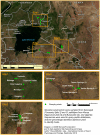Tracking the feeding patterns of tsetse flies (Glossina genus) by analysis of bloodmeals using mitochondrial cytochromes genes
- PMID: 21386971
- PMCID: PMC3046180
- DOI: 10.1371/journal.pone.0017284
Tracking the feeding patterns of tsetse flies (Glossina genus) by analysis of bloodmeals using mitochondrial cytochromes genes
Abstract
Tsetse flies are notoriously difficult to observe in nature, particularly when populations densities are low. It is therefore difficult to observe them on their hosts in nature; hence their vertebrate species can very often only be determined indirectly by analysis of their gut contents. This knowledge is a critical component of the information on which control tactics can be developed. The objective of this study was to determine the sources of tsetse bloodmeals, hence investigate their feeding preferences. We used mitochondrial cytochrome c oxidase 1 (COI) and cytochrome b (cytb) gene sequences for identification of tsetse fly blood meals, in order to provide a foundation for rational decisions to guide control of trypanosomiasis, and their vectors. Glossina swynnertoni were sampled from Serengeti (Tanzania) and G. pallidipes from Kenya (Nguruman and Busia), and Uganda. Sequences were used to query public databases, and the percentage identities obtained used to identify hosts. An initial assay showed that the feeds were from single sources. Hosts identified from blood fed flies collected in Serengeti ecosystem, included buffaloes (25/40), giraffes (8/40), warthogs (3/40), elephants (3/40) and one spotted hyena. In Nguruman, where G. pallidipes flies were analyzed, the feeds were from elephants (6/13) and warthogs (5/13), while buffaloes and baboons accounted for one bloodmeal each. Only cattle blood was detected in flies caught in Busia and Uganda. Out of four flies tested in Mbita Point, Suba District in western Kenya, one had fed on cattle, the other three on the Nile monitor lizard. These results demonstrate that cattle will form an integral part of a control strategy for trypanosomiasis in Busia and Uganda, while different approaches are required for Serengeti and Nguruman ecosystems, where wildlife abound and are the major component of the tsetse fly food source.
Conflict of interest statement
Figures
Similar articles
-
Quantifying Heterogeneity in Host-Vector Contact: Tsetse (Glossina swynnertoni and G. pallidipes) Host Choice in Serengeti National Park, Tanzania.PLoS One. 2016 Oct 5;11(10):e0161291. doi: 10.1371/journal.pone.0161291. eCollection 2016. PLoS One. 2016. PMID: 27706167 Free PMC article.
-
Hosts of Glossina fuscipes fuscipes and G. pallidipes in areas of western Kenya with endemic sleeping sickness, as determined using an egg-yolk (IgY) ELISA.Ann Trop Med Parasitol. 2007 Apr;101(3):225-32. doi: 10.1179/136485907X156979. Ann Trop Med Parasitol. 2007. PMID: 17362597
-
Apparent density, trypanosome infection rates and host preference of tsetse flies in the sleeping sickness endemic focus of northwestern Uganda.BMC Vet Res. 2021 Nov 29;17(1):365. doi: 10.1186/s12917-021-03071-w. BMC Vet Res. 2021. PMID: 34839816 Free PMC article.
-
Advancements in bait technology to control Glossina swynnertoni Austen, the species of limited distribution in Kenya and Tanzania border: A review.J Vector Borne Dis. 2017 Jan-Mar;54(1):16-24. J Vector Borne Dis. 2017. PMID: 28352042 Review.
-
A scoping review on tsetse fly blood meal sources and its assay methods since 1956 to 2022.Parasit Vectors. 2024 Feb 2;17(1):52. doi: 10.1186/s13071-023-06114-3. Parasit Vectors. 2024. PMID: 38308365 Free PMC article.
Cited by
-
Tsetse Bloodmeal Analyses Incriminate the Common Warthog Phacochoerus africanus as an Important Cryptic Host of Animal Trypanosomes in Smallholder Cattle Farming Communities in Shimba Hills, Kenya.Pathogens. 2021 Nov 18;10(11):1501. doi: 10.3390/pathogens10111501. Pathogens. 2021. PMID: 34832656 Free PMC article.
-
The Transmission of Animal African Trypanosomiasis in Two Districts in the Forest Zone of Ghana.Am J Trop Med Hyg. 2024 May 2;110(6):1127-1136. doi: 10.4269/ajtmh.23-0329. Print 2024 Jun 5. Am J Trop Med Hyg. 2024. PMID: 38697074 Free PMC article.
-
Improving Sterile Insect Technique (SIT) for tsetse flies through research on their symbionts and pathogens.J Invertebr Pathol. 2013 Mar;112 Suppl(0):S2-10. doi: 10.1016/j.jip.2012.07.009. Epub 2012 Jul 24. J Invertebr Pathol. 2013. PMID: 22841636 Free PMC article. Review.
-
Unbiased Characterization of Anopheles Mosquito Blood Meals by Targeted High-Throughput Sequencing.PLoS Negl Trop Dis. 2016 Mar 10;10(3):e0004512. doi: 10.1371/journal.pntd.0004512. eCollection 2016 Mar. PLoS Negl Trop Dis. 2016. PMID: 26963245 Free PMC article.
-
Socio-economic and cultural determinants of human african trypanosomiasis at the Kenya - Uganda transboundary.PLoS Negl Trop Dis. 2013 Apr 25;7(4):e2186. doi: 10.1371/journal.pntd.0002186. Print 2013. PLoS Negl Trop Dis. 2013. PMID: 23638206 Free PMC article.
References
-
- Pepin J, Meda HA. The epidemiology and control of human African trypanosomiasis. Adv Parasitol. 2001;49:71–132. - PubMed
-
- Aksoy S. Control of tsetse flies and trypanosomes using molecular genetics. Vet Parasitol. 2003;115:125–145. - PubMed
-
- Schofield CJ, Kabayo JP. Trypanosomiasis vector control in Africa and Latin America. 24Parasit Vectors. 2008;1 DOI: 10.1186/1756-3305-1-24 ( http://www.parasitesandvectors.com) - PMC - PubMed
-
- Jordan AM. Control of tsetse flies (Diptera: Glossinidae) with the aid of attractants. J Am Mosq Control Assoc. 1995;11:249–255. - PubMed
Publication types
MeSH terms
Substances
LinkOut - more resources
Full Text Sources


